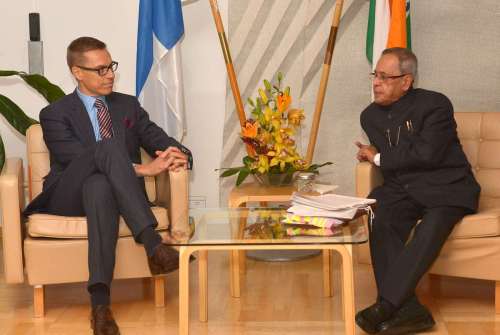
By Ranjana Narayan
With the resource-rich Arctic region becoming the focus of heightened attention, President Pranab Mukherjee’s visit to the two Nordic countries of Norway and Finland last week was a crucial step by India to assert its “willingness to have a strong presence in the Arctic Council and to work closely with” the eight countries of the region.
Mukherjee, who paid a six-day visit to the two countries from Oct 12, was also the first Indian president to cross the Arctic Circle when he visited the village of Santa Claus in the Finnish town of Rovaniemi.
Last year, India, along with China, Japan and South Korea, were granted observer status to the Arctic Council. Its eight members are Canada, Denmark, Finland, Iceland, Norway, Russia, Sweden and the US.
A United States Geological Survey (USGS) report of 2008 says that the Arctic seabed contains nearly 20 percent of the world’s oil reserves and 30 percent of undiscovered gas deposits.
With global warming melting the sea ice around the Arctic in the summer months by around 40 percent over the past few decades, a shorter sailing route across the Northern Sea is also opening up a new maritime proposition. Taking the Northern Sea Route rather than the Panama Strait is estimated to shorten the journey between the Pacific and Atlantic Oceans by about one third (roughly 4,000 nautical miles) of the total, according to estimates.
“The Arctic has great significance; it is a new maritime region opening up. And the president himself actually going to the Arctic Circle shows our commitment to the fact that we are willing to have a strong presence in the Arctic Council and willing to work more closely with the countries involved; keeping in view their sensitivities on environment, on indigenous population, on proper use of resources,” a senior official, who had accompanied the president, told IANS.
“We are not there to just go and try break through and get what we want, we have to work with the people, with the Arctic Council. We also explained to them what kind of research goes on the Arctic, which was very well received,” the official, who did not wish to be named, said.
India has a research station, Himadri, in Svalbard, Norway, set up in 2008. President Mukherjee spoke to the around five scientists present at Himadri through radio link. He also spoke to three Indian Ph.D. students who are working on various aspects of Arctic research at the University of Svalbard.
The Indian scientists are conducting research on climate change, on the changing nature of Arctic glaciers, glaciology, microbiology, and also monitoring changes below the Arctic Sea, which would shed light on how the ice is melting, and how it would impact the Indian monsoon.
The official said that while the shortened sea route in the Arctic is a possibility but India would work with other countries on that. “We are engaging significantly with the Arctic Council, India’s polar research is recognized,” he said, adding that last year then external affairs minister Salman Khurshid had visited the Himadri station and President Mukherjee’s recent visit the region “shows our commitment to working with them on all fronts”.
Mukherjee was accompanied by 45 business people and senior educationists on the trip, which saw several agreements inked between the Indian businesspersons with their counterparts from the two countries, as well as between Indian educationists and heads of educational institutes from Norway and Finland.
Besides talks on trade and investment, clean technology and IT, India also held talks on deep sea fishing and ports with both countries.
Norway has tremendous expertise in deep-sea fishing and its technology, including krill fishing. India is looking at ways and means for cooperation in this regard, Navej Sarna, Secretary (West) in the Ministry of External Affairs said at a briefing ahead of the visit.
Mukherjee, during his talks with the leadership there, also positioned India as a manufacturing hub and as a viable investment destination under the Narendra Modi government’s “Make in India” slogan.